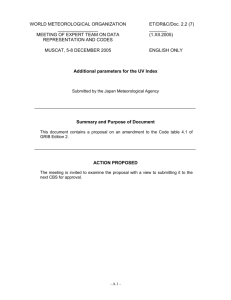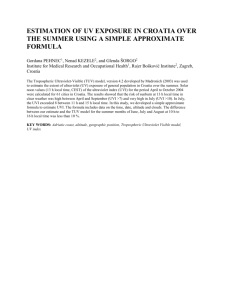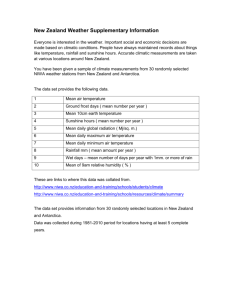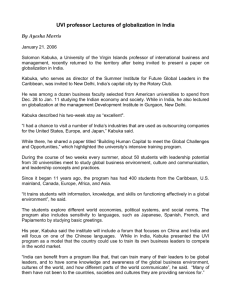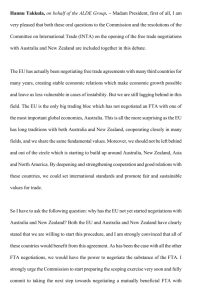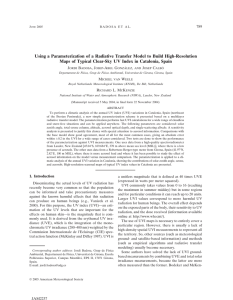UV radiation in New Zealand and Australia: What makes us
advertisement
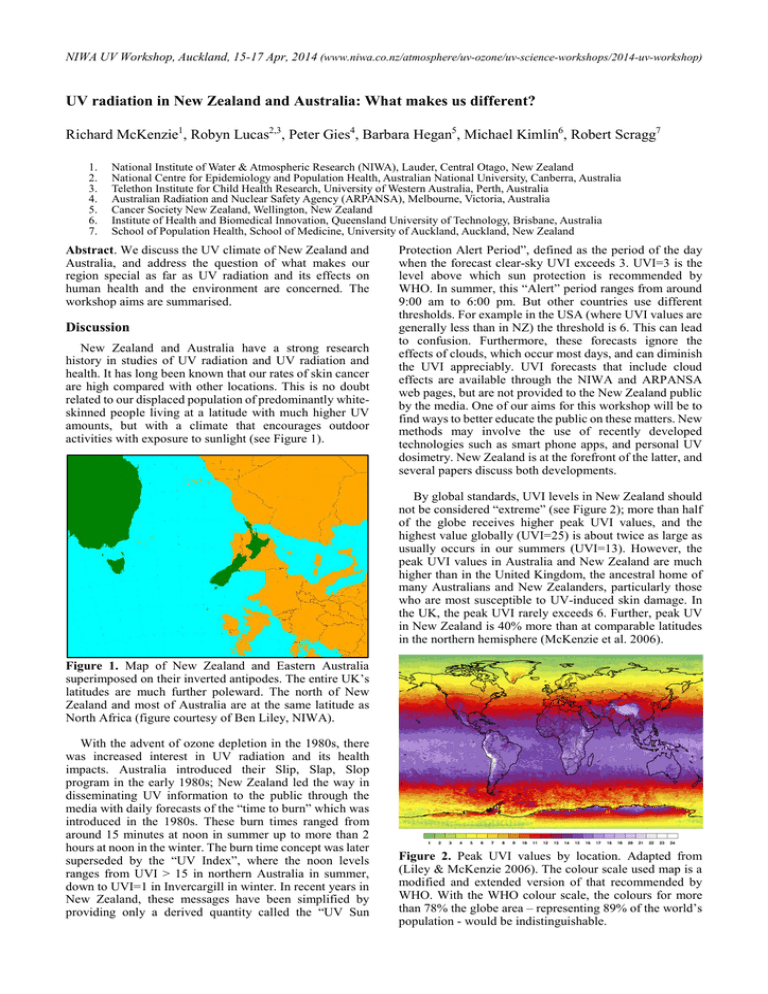
NIWA UV Workshop, Auckland, 15-17 Apr, 2014 (www.niwa.co.nz/atmosphere/uv-ozone/uv-science-workshops/2014-uv-workshop) UV radiation in New Zealand and Australia: What makes us different? Richard McKenzie1, Robyn Lucas2,3, Peter Gies4, Barbara Hegan5, Michael Kimlin6, Robert Scragg7 1. 2. 3. 4. 5. 6. 7. National Institute of Water & Atmospheric Research (NIWA), Lauder, Central Otago, New Zealand National Centre for Epidemiology and Population Health, Australian National University, Canberra, Australia Telethon Institute for Child Health Research, University of Western Australia, Perth, Australia Australian Radiation and Nuclear Safety Agency (ARPANSA), Melbourne, Victoria, Australia Cancer Society New Zealand, Wellington, New Zealand Institute of Health and Biomedical Innovation, Queensland University of Technology, Brisbane, Australia School of Population Health, School of Medicine, University of Auckland, Auckland, New Zealand Abstract. We discuss the UV climate of New Zealand and Australia, and address the question of what makes our region special as far as UV radiation and its effects on human health and the environment are concerned. The workshop aims are summarised. Discussion New Zealand and Australia have a strong research history in studies of UV radiation and UV radiation and health. It has long been known that our rates of skin cancer are high compared with other locations. This is no doubt related to our displaced population of predominantly whiteskinned people living at a latitude with much higher UV amounts, but with a climate that encourages outdoor activities with exposure to sunlight (see Figure 1). Protection Alert Period”, defined as the period of the day when the forecast clear-sky UVI exceeds 3. UVI=3 is the level above which sun protection is recommended by WHO. In summer, this “Alert” period ranges from around 9:00 am to 6:00 pm. But other countries use different thresholds. For example in the USA (where UVI values are generally less than in NZ) the threshold is 6. This can lead to confusion. Furthermore, these forecasts ignore the effects of clouds, which occur most days, and can diminish the UVI appreciably. UVI forecasts that include cloud effects are available through the NIWA and ARPANSA web pages, but are not provided to the New Zealand public by the media. One of our aims for this workshop will be to find ways to better educate the public on these matters. New methods may involve the use of recently developed technologies such as smart phone apps, and personal UV dosimetry. New Zealand is at the forefront of the latter, and several papers discuss both developments. By global standards, UVI levels in New Zealand should not be considered “extreme” (see Figure 2); more than half of the globe receives higher peak UVI values, and the highest value globally (UVI=25) is about twice as large as usually occurs in our summers (UVI=13). However, the peak UVI values in Australia and New Zealand are much higher than in the United Kingdom, the ancestral home of many Australians and New Zealanders, particularly those who are most susceptible to UV-induced skin damage. In the UK, the peak UVI rarely exceeds 6. Further, peak UV in New Zealand is 40% more than at comparable latitudes in the northern hemisphere (McKenzie et al. 2006). Figure 1. Map of New Zealand and Eastern Australia superimposed on their inverted antipodes. The entire UK’s latitudes are much further poleward. The north of New Zealand and most of Australia are at the same latitude as North Africa (figure courtesy of Ben Liley, NIWA). With the advent of ozone depletion in the 1980s, there was increased interest in UV radiation and its health impacts. Australia introduced their Slip, Slap, Slop program in the early 1980s; New Zealand led the way in disseminating UV information to the public through the media with daily forecasts of the “time to burn” which was introduced in the 1980s. These burn times ranged from around 15 minutes at noon in summer up to more than 2 hours at noon in the winter. The burn time concept was later superseded by the “UV Index”, where the noon levels ranges from UVI > 15 in northern Australia in summer, down to UVI=1 in Invercargill in winter. In recent years in New Zealand, these messages have been simplified by providing only a derived quantity called the “UV Sun Figure 2. Peak UVI values by location. Adapted from (Liley & McKenzie 2006). The colour scale used map is a modified and extended version of that recommended by WHO. With the WHO colour scale, the colours for more than 78% the globe area – representing 89% of the world’s population - would be indistinguishable. NIWA UV Workshop, Auckland, 15-17 Apr, 2014 (www.niwa.co.nz/atmosphere/uv-ozone/uv-science-workshops/2014-uv-workshop) Now that the threat of wholesale ozone destruction has been averted though the success of the Montreal Protocol on Protection of the Ozone Layer, interest in UV radiation has diminished somewhat. Concerns remain about possible interactions between climate change and future exposure to UV radiation, but continuing increases in skin cancer rates means that we cannot be complacent. We must ensure greater awareness and understanding of advisable sun exposure within the population. Finally we want to better understand some of the positive effects of UV exposure. Mid latitude locations, particularly the southern parts of New Zealand and Australia have large seasonal changes in doses of UV radiation, with wintertime biologically effective doses being less than 5% of those in summer (see Figure 3). Consequently, we have two problems with exposure to UV radiation: 1. Too much UV radiation in the summer (especially in the north, and for lighter skin types), and 2. Too little UV radiation in the winter (especially in the south, and for darker skin types) Several papers will investigate the relationship between exposure to UV radiation and vitamin D status. Through these studies we hope to work towards formulating better advice on sun exposure to optimise vitamin D without increasing the risks of adverse health outcomes. Given that the UVI in the UK rarely exceeds 6, and that in that region skin cancer rates are less than half of those in New Zealand and Australia, there may be good public uptake of the suggestion that they should avoid unnecessary exposure when the UVI exceeds 6. But, for this to happen, the public need to know when the UVI is likely to be greater than that threshold. We have the means to provide the information, but we need a better vehicle. The same vehicle should be used year round to provide information on the low UVI in winter when we may wish to encourage greater exposure to UV radiation. We can learn a lot from each other about the most effective messages and tools to communicate sun safety to our populations. It’s good to see representation from further afield – to use our collective expertise to address the challenges of optimal sun exposure. We wish all well for a successful and profitable two days of discussions. Summary of Workshop Aims • Provide a forum for discussing progress in what has become a highly multi-disciplinary area of research. Identify new areas of research, potential research partners, and funding opportunities. • Improve understanding of the production of vitamin D from UV, and its role in human health. • Improve public awareness of UV issues, and the way UV information is disseminated to the public. • Identify new projects that make use of newly developed technologies (e.g., smart phones, GPS capabilities, personal UV dosimeters). • Improve understanding of the positive and negative health issues associated with UV, to enable formulation of the best advice to balance these issues. References Figure 3. Samples of UVI forecasts, showing the huge seasonal and geographical range in UVI values in New Zealand. The UV Alert threshold is also shown. See NIWA website https://www.niwa.co.nz/our-services/onlineservices/uv-and-ozone/forecasts Liley, J.B., McKenzie, R.L. 2006. Where on Earth has the highest UV? Paper at UV Radiation and its Effects: an update, Dunedin, 19-21 April. McKenzie, R.L., Bodeker, G.E., Scott, G., Slusser, J. 2006. Geographical differences in erythemally-weighted UV measured at mid-latitude USDA sites. Photochemical & Photobiological Sciences 5(3): 343-352.
